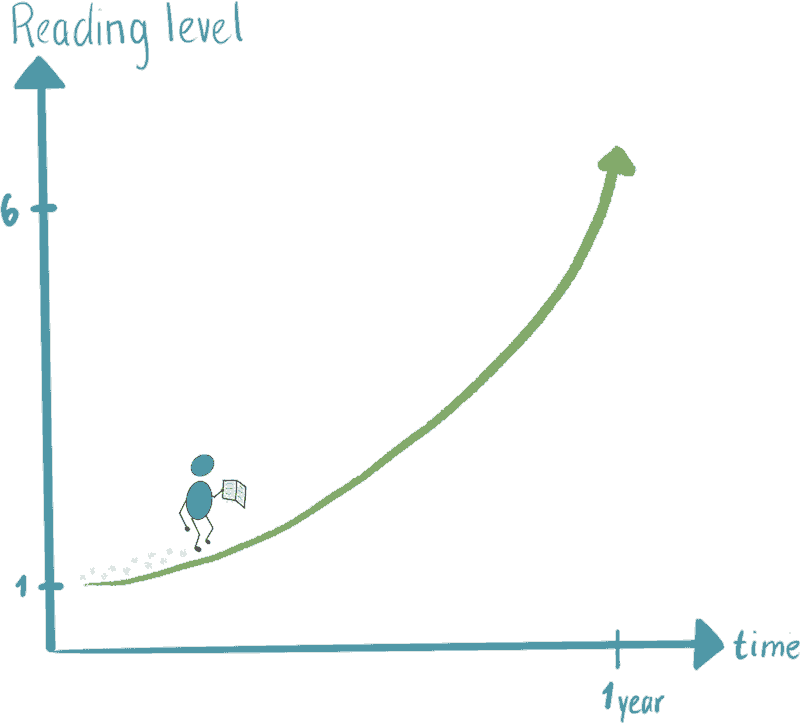MOTIVATION IS IMPORTANT FOR LEARNING…
But perhaps your child is motivated to neither read nor learn anything new because the letters don’t make sense.
This applies in English, Math, Spanish, or any subject.
You might be thinking, “How do I motivate my dyslexic child to read?”
You may have reached a point where it becomes challenging to keep coming up with a “carrot” to put in front of your child…
And your child is still not motivated to sit for 20 minutes and read letters that aren’t making any sense.
Instead, the letters show your child over and over that they don’t understand the sounds in the same way their peers do or as their teachers expect.
Sigh. What are you supposed to do?
Can you even motivate yourself to keep trying to encourage your child?
Can I be honest?
… The answer is, actually, no!
BUT fortunately, you can help your child find the motivation to improve their reading.
If you are up for it, I would like to tell you why motivation cannot be pulled straight from a drawer under the desk. And what you can do to help your child with the letters.
So, let’s take a closer look at all this together.
My child is dyslexic
“What is dyslexia, and what does it mean for my child?” Have you also been searching for answers to that?
Understand your dyslexic child
It can be challenging to be a parent and help with the homework without getting frustrated.
Use the apps and tools
Have you also thought about what apps and programs that are best? Then your child could get their homework done without issues…
WHAT IS MOTIVATION?
First, I would like to give you a short overview of what motivation actually is.
Just so we are on the same page because there are many approaches.
You might have had the same question that I had, Is motivation when I get a dessert for doing something my mum asks me to?
Or am I motivated when I find whatever I am doing exciting?
Or a third option?
To put it briefly: Motivation is what gives us the energy to take action.
According to a widely accepted approach, there are four fundamental types of motivation, and I would like to introduce them to you.
1 – Inner motivation
Your child gets this when their efforts create an inner joy.
For instance, it happens when your child receives information about something they are interested in.
For me, it happens if I read about a subject I find interesting. Or if I am listening to a podcast that makes me want to read up on a topic.
Then my reading is entirely voluntary.
2 – Outer motivation
Your child reaches this when their actions, for instance, give them praise from you or good grades from the teacher.
For dyslexic people, in particular, this type of motivation is often turned around and becomes negative because we try to avoid a consequence. We refrain from reading because we know that it won’t give us satisfaction and good praise, but often uncomfortable experiences.
As a child, I could reach outer motivation. The positive version was when my mum praised me whenever I read some words correctly.
But I often avoided reading and came up with all kinds of trouble in school so I wouldn’t have to read out loud. I’d rather be scolded than risk my peers and teachers finding out that I didn’t know the letters.
I wouldn’t encourage your child to use this strategy. But unfortunately, it is often a way to hide our weaknesses.
3 – Social motivation
Your child gets social motivation when they create happiness and satisfaction in others. It is not about pleasing others but instead ensuring that your child gets a feeling that they mean something to others.
For instance, it could be your child helping a younger sibling reading something out loud.
I cannot remember having found social motivation by reading.
(And that is not just because I, as the youngest, didn’t have anyone to help read something.)
But I found it in my free time when I played handball. I was good at it, and my actions on the court meant something for the entire team.
4 – Performance motivation
Your child obtains this when their performance strengthens their ego and is a better motivation than the others. I rarely achieved this type of motivation in school.
However, I did experience it when I got older; when we had projects I could contribute to through other things than letters and words.
I displayed my efforts to learn and understand new things to the teacher through, for example, models of things we worked with. I could present a lot of topics by using those. I didn’t need a poster filled with words to present for my peers and teachers.
The dyslexic brain
Have you also been wondering if there is something wrong with your dyslexic child’s brain? That is, why the head cannot comprehend those pesky letters.
Accepting the dyslexia
Is your child also finding it difficult to talk about their thoughts and emotions when the letters are teasing them?
Difficulty with learning how to read
Does my child have reading difficulties or dyslexia? You can see that your child is struggling with the letters, but how does your child progress?
WHAT ABOUT THE REWARDS?
Both inner and social motivation, and to a certain extent performance motivation, create the best type of learning.
But what about outer motivation?
That is the type of motivation we all use when we praise our children’s performance and come up with rewards to make our children study.
Yes, but this type of motivation is only obtained by your child for the sake of praise and acknowledgment.
That means your child won’t necessarily learn anything in-depth.
If praise and acknowledgment drive your child toward real gratification, it’s probably more a case of social motivation than outer motivation.
Furthermore, it also important to remember that what is motivating you may not motivate your child.
OK, but then why is motivation important?
MOTIVATION IS IMPORTANT FOR LEARNING
It is very straightforward.
If we aren’t motivated, we won’t do anything.
Biologically speaking, then, motivation is a tool to survive. When our own actions create happiness and enjoyment, then we will work toward new goals. We are, so to speak, created to motivate ourselves.
That also means you cannot motivate your child. Your child has to get motivated themself to take action.
However, you can create an environment where your child will be motivated.
WHY YOU CANNOT MOTIVATE YOUR CHILD TO JUST ANYTHING…
Let me explain further.
Your child needs self-determination. We all do.
It means that we need autonomy, competence, and a sense of community.
First and foremost, it means that the way we behave must be approved by ourselves and adhere to our values and interests.
This autonomy means that we can do something that other people want us to do if it fits with our own values.
We also need competence.
This means that we should be able to create a result in our environment. We need a sense of doing something meaningful.
Furthermore, we also want to develop a sense of community with other people—the feeling of being part of a social community.
When we have all three elements, we can motivate ourselves.
So, you can only make your child do something if your child experiences it as something in line with what your child thinks is fair and interesting.
For instance, I become motivated to read something that interests me; not something others tell me to do so I can be better at reading.
So, what can you actually do?
3 SUGGESTIONS FOR YOU
Besides being conscious about the fact that your child may not be motivated by what motivates you and focusing on creating an environment that will allow your child to experience their own motivation, I also have three suggestions for you.
1 – Help your child find something interesting
As a dyslexic person, one isn’t a champion at reading, and I think very few dyslexic people enjoy constantly being told that they aren’t good at reading.
If your child is to be motivated to practice reading, then it has to be because reading is interesting.
The inner motivation has to be engaged so that your child thinks, “That is awesome. I would like to learn more about that.”
And then it doesn’t matter what the subject is.
Football, parkour, woodlice, cakes, Icelandic ponies, tractors, embroidery…
2 – Give all your love
Your child isn’t stupid.
Anybody can always practice and get better.
Already, right there, your child will see that there is a chance that the letters will not always be in charge.
And the letters should not decide how your child learns.
That is why I have written an article about different learning styles, where you can find inspiration to open your child’s eyes to their own possibilities.
3 – Make small steps (and change the context)
You have probably read this whole article because it’s been difficult to get your child to read, and you would like to change that.
Your child might not feel that he or she has control over the letters. And how awesome is it to keep doing something you don’t have the competence to do?
But seeing that it can be done can create a positive performance motivation.
So, for instance, instead of reading for 20 minutes every day, you may need to start with smaller steps and only read for a few minutes.
I can actually give you a bit of math as well.
If your child improves by just 0.5 percent every day (yes, those are small steps), then your child would be six times better in a year.
The math is just to illustrate my point that starting small can bring great results.
Sometimes, it helps to change the context; that means how, when, and where your child’s reading takes place.
It could be that reading should not take place just before dinner, when the energy is too low, but instead afterward, when the energy is high.
It might also be that you have to sit together somewhere cozy, or that your child prefers to sit alone without interruptions.
There are many options, and you can get inspired by your child’s preferred reading style.
All in all, you must create an environment to ensure that your child realizes that their efforts make it easier to read. Then your child will be motivated.
Learning styles as a dyslexic person
Many believe that a dyslexic person has more difficulties learning and fewer options for further education. But that is not true…
The joy of learning new things
Feelings are the primary motor for learning. Do you also wish that your child would be more eager to learn new things in school?
Jesper Sehested
Dyslexic, author, speaker and mentor
Sources:
- Biggs, J. & Tang, C. (2011), ‘Teaching for Quality Learning at University’
- Lauridsen, Ole (2016), ‘Hjernen og læring’
- Ryan, Richard M. & Deci, Edward L. (2017), ‘Self-determination Theory: Basic Psychological Needs in Motivation, Development, and Wellness’










